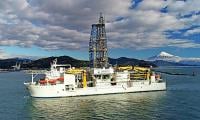A nuclearised Indian Ocean
While the international strategic community continues to be preoccupied with land-based nuclear developments in the South Asian region, little attention is being paid to the fearsome prospect of the nuclearisation of the Indian Ocean, and the adjoining waters of the Arabian Sea and the Bay of Bengal.
The induction of nuclear weapons and platforms in the Indian Ocean by any one state of the 32 littoral states around it will have the consequence of jeopardising the security of all the others. As the state undertaking this enterprise is India, it can directly affect the security dilemma of Pakistan, which is already concerned about India’s land-based nuclear and missile capabilities.
When India embarked upon a military nuclear programme way back in the 70s, Pakistan had to follow suit, given the conflict-ridden relationship that it had had with India. This phase eventually culminated in 1998 when the two countries developed overt nuclear weapons capabilities. As if this was not worrisome enough, India now seems bent on introducing nuclear weaponry in the seas, which would further exacerbate the South Asian security environment.
Unfortunately, the Indian Ocean is fast becoming an arena of global strategic competition, largely due to the US’s attempt to establish its influence in the Asia Pacific region, to counter possible Chinese presence in the area. In this scheme of things, the US could well be encouraging India to go ahead with its aggressive designs of dominating the Indian Ocean with the building of nuclear capable sea-based platforms. In any case, India has since long had plans for developing a strong and powerful blue water navy. The latest articulation of this ambition can be found in India’s Naval Strategy document of 2015.
India has chosen to pursue, as a key element of its naval strategy, the goal of becoming a regional hegemon in the Indian Ocean, including the Arabian Sea and the Bay of Bengal. By developing the capability of denying the other littoral states access to the ocean’s resources – including, perhaps, communication and free movement as and when it so wishes – it can directly threaten the core interests of all the littoral states through its enhanced naval power, which is a frightening prospect. As it appears, India is poised to pursue the following nefarious designs in the Indian Ocean region:
• Developing a sea-based deterrent to undermine Pakistan’s perceived notion of deterrence stability vis-à-vis India;
• Enforcing India’s presumed right to regulate strategic and economic activities in the Indian Ocean, tacitly approved by the US;
• Commanding sea-lines of communication (SLOCs) and to control key choke points to neutralise China’s influence; and
• Ensuring operational readiness to engage in littoral warfare.
Towards these ends, India is developing a sub-surface fleet of different kinds of submarines. It has been acquiring both nuclear-powered attack submarine (SSN) and the ballistic missile submarine (SSBN). A nuclear-powered attack submarine is designed to target adversary’s ships by using torpedoes or cruise missiles, and a nuclear-armed submarine carries long-range nuclear ballistic missiles, and its ability to survive enemy’s nuclear attack makes it the most credible nuclear deterrent to achieve assured second strike capability.
The INS Chakra is so far the first and only operational nuclear attack submarine in the Indian fleet. This nuclear-powered attack submarine (SSN) was commissioned in the Indian Navy in April 2012. It made India the only country besides the five nuclear-weapons states to operate an SSN. Acquired on a ten-year lease from Russia, the INS Chakra gives the Indian Navy operational flexibility that increases its effectiveness, particularly in blue-water operations.
India is currently in negotiations with Russia to acquire another submarine of this class. Additionally, the Indo-Russian joint production has helped India acquire the Talwar class frigates. The new frigates of this kind are armed with eight Brahmos missiles, capable of carrying nuclear warheads. This missile can be launched from submarines, surface ships, land and air, thereby providing additional strength to its nuclear arsenal.
India’s Advanced Technology Vessel (ATV) Project, under the joint supervision of the Indian Navy, the Bhabha Atomic Research Centre (BARC) and the Defence Research and Development Organisation (DRDO) has been under development since 1999. This project produced its first nuclear ballistic missile submarine, the INS Arihant, which has completed its critical diving tests and undergone the test launch of unarmed ballistic missiles.
The hulls of another two SSBNs, including INS Aridhaman, have already been completed and these vessels are expected to be launched by 2017. On March 31 this year India conducted a test of the K-4, an intermediate range nuclear-capable submarine-launched ballistic missile, from the indigenously built submarine the INS Arihant in the Bay of Bengal. The K-4 and the projected K-5 will thus become parts of its nuclear triad, enabling India to have second strike nuclear capability.
India’s naval nuclear developments will qualitatively alter the strategic balance between India and Pakistan in favour of the former, which might compel Pakistan to again follow suit to rebalance the deterrence stability between the two countries in the region. This would not only instigate an arms race in the region, but will also raise questions regarding India’s professed minimalist policies. India’s strategic partnerships with major powers further help it to develop its naval nuclear assets. Great proponents of non-proliferation, these powers happily ignore the fact that the vertical proliferation of a de-facto nuclear weapon state poses severe challenges to the international non-proliferation regime.
For Pakistan, the strategic stability in the region will be irreversibly disturbed by India’s on-going sea-based programmes. As regards the Indian Ocean, the danger is that it could become the most nuclearised of the seven seas. The great nuclear powers are already present there, and it is now threatened by Indian designs too. The induction of nuclear platforms in these fateful waters is a danger to the entire security environment of this part of the world.
The writer is the executive director of the Center for International Strategic Studies.
Email: sarwarnaqvi@yahoo.com
-
 Prince Harry Breaks Cover In California Amid Tension At Home With Meghan Markle
Prince Harry Breaks Cover In California Amid Tension At Home With Meghan Markle -
 ASAP Rocky Makes Massive Comeback With New Album
ASAP Rocky Makes Massive Comeback With New Album -
 Amanda Seyfried Unveils How Channing Tatum Teased Her On 'Dear John' Set
Amanda Seyfried Unveils How Channing Tatum Teased Her On 'Dear John' Set -
 Blue Moon 2026: Everything You Need To Know
Blue Moon 2026: Everything You Need To Know -
 UN Warns Of 10-year Worst Hunger Crisis In Nigeria After Massive Aid Cuts
UN Warns Of 10-year Worst Hunger Crisis In Nigeria After Massive Aid Cuts -
 Dolly Parton Drops New Version Of Her 1977 Hit 'Light Of A Clear Blue Morning'
Dolly Parton Drops New Version Of Her 1977 Hit 'Light Of A Clear Blue Morning' -
 Redmi Note 15 Pro+5G Set For Global Rollout With Power-packed Features
Redmi Note 15 Pro+5G Set For Global Rollout With Power-packed Features -
 Meghan Markle Sparks Huge Tension With Harry At Home: 'At A Critical Crossroads'
Meghan Markle Sparks Huge Tension With Harry At Home: 'At A Critical Crossroads' -
 Insurrection Act Of 1807: All You Need To Know About Powerful US Emergency Law
Insurrection Act Of 1807: All You Need To Know About Powerful US Emergency Law -
 Philippines Blocks Elon Musk’s Grok AI
Philippines Blocks Elon Musk’s Grok AI -
 Jennifer Lawrence Blames Internet For Losing Sharon Tate Role
Jennifer Lawrence Blames Internet For Losing Sharon Tate Role -
 DeepMind, Google CEOs Sync Daily To Accelerate AI Race Against OpenAI
DeepMind, Google CEOs Sync Daily To Accelerate AI Race Against OpenAI -
 Japan Launches Probe Into 'Grok AI' Following Global Scrutiny Over 'inappropriate' Content
Japan Launches Probe Into 'Grok AI' Following Global Scrutiny Over 'inappropriate' Content -
 Prince Harry All Set To Return To Britain Next Week?
Prince Harry All Set To Return To Britain Next Week? -
 Is Princess Charlotte Becoming Most Confident Young Royal?
Is Princess Charlotte Becoming Most Confident Young Royal? -
 ‘Stranger Things’ Star David Harbour Speaks Up About ‘psychotherapy’
‘Stranger Things’ Star David Harbour Speaks Up About ‘psychotherapy’



